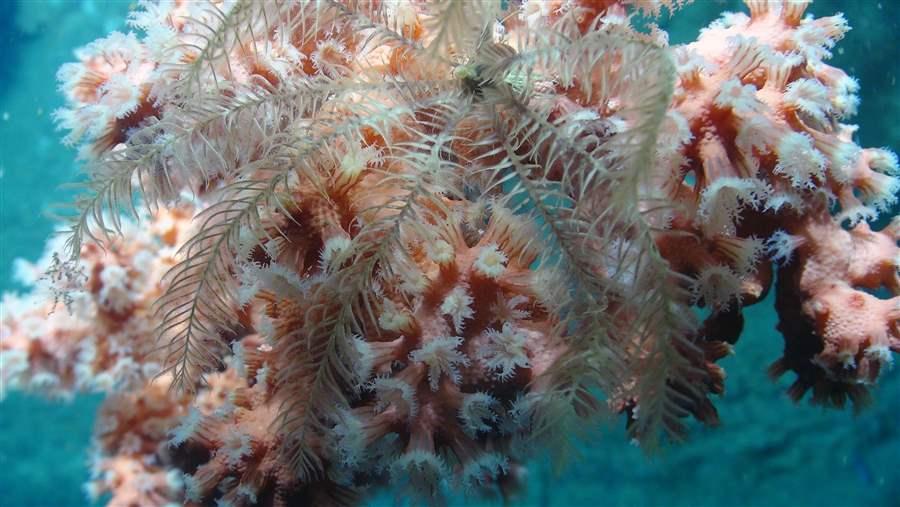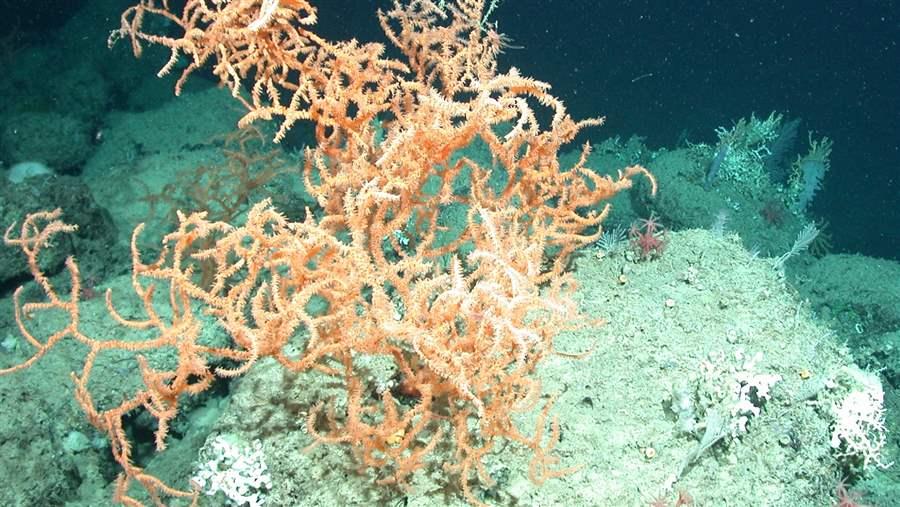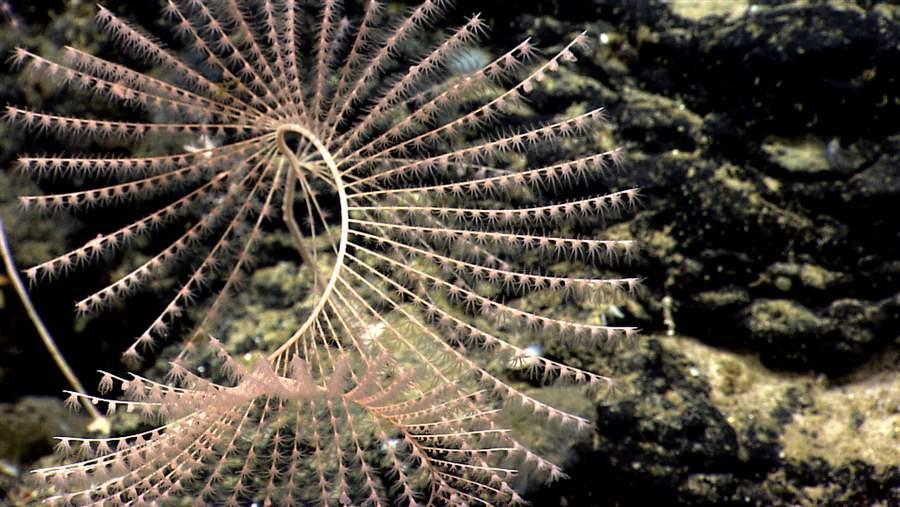Ancient Deep Sea Corals Need Protection From Modern Threats

Sandra Brooke on board the research vessel Atlantis, with the submersible Alvin behind her, in 2000. During this trip off the Central American coast, she logged her third dive to the East Pacific Rise hydrothermal vents in the eastern Pacific Ocean.
© Courtesy of Sandra Brooke
For 90 minutes, Sandra Brooke sat in the chilly darkness of a titanium sphere as she dropped more than 8,000 feet into the Pacific Ocean off Costa Rica.
When she and another scientist in the small submarine reached the bottom, where two of the Earth’s tectonic plates meet, their onboard pilot flipped on the outside lights.

The Johnson-Sea-Link submersible, carrying Brooke and pilot Don Libertore, returns from a dive to the deck of a research vessel after exploring deep-sea corals off the east-Central Florida coast in 2005. Harbor Branch Oceanographic Institute in South Florida owned and operated the submersible.
© Courtesy of Sandra Brooke
“It’s amazing. You’re looking at an ecosystem that shouldn’t exist,” recalls Brooke, a researcher at Florida State University’s Coastal and Marine Laboratory. “It’s 4 degrees Celsius, with incredible pressures and noxious gases escaping as the plates are moving and the seafloor is spreading apart.”
Brooke’s first journey in the famous Woods Hole Oceanographic Institute’s submersible Alvin, in 1999, took her to seabed fissures that spew water heated from deep within the planet. These hydrothermal vents play host to other-worldly species such as giant tubeworms, and as the vents shift with the tectonic plates, corals can colonize the bare rock left behind.

A marine animal known as a crinoid (foreground), which is related to sea urchins, takes up residence on pink bubblegum coral (Paragorgia arborea) hundreds of feet underwater in Norfolk Canyon off the coast of Virginia. These are the most common corals in the underwater canyons of the Mid-Atlantic Bight, the long, gradual bend in the shoreline and continental shelf from southern New England to Cape Hatteras, North Carolina.
© Deepwater Canyons—Pathways to the Abyss, NOAA-OER/BOEM/USGS
But deep-sea corals, Brooke’s specialty, aren’t found only thousands of feet below the surface. They’re spread throughout the world’s oceans, and she has traveled far and wide—including four trips in Alvin plus journeys in other submersible vehicles—to study these fragile organisms, which grow in a variety of formations and can live for thousands of years.
Deep-sea corals form reefs, mounds, and undersea forests. Some species are pure white, and others are brightly colored; some branch widely while others, such as certain types of stony corals, can form structures hundreds of feet tall. All thrive in cold, dark water. Brooke’s focus is the slow-growing species Lophelia pertusa, which builds reefs as new coral polyps stack upon the skeletal remains of previous generations.

A golden crab finds shelter under Lophelia coral in the eastern Gulf of Mexico.
© USGS Diversity, Systematics, and Connectivity of Vulnerable Reef Ecosystems.
“Corals look like beautiful flowers and yet are voracious carnivores that capture small prey in their tentacles. They also battle each other for space on the reef using large stinging cells,” says Brooke, who grew fascinated with coral during her research at Harbor Branch Oceanographic Institute at Florida Atlantic University.
Government leaders and marine management bodies that oversee oceans from New Zealand to the Arctic, in national waters and on the high seas, are recognizing the importance of deep coral communities and their vulnerabilities to human activities. For example, in the Gulf of Mexico—where corals provide homes for countless invertebrates, such as sponges, sea urchins, and crabs, and such fish as large grouper and sharks—fishery managers are considering protecting more of these ocean jewels, based in part on research by Brooke and her colleagues. Among other threats, deep corals in the Gulf are at risk from oil spills, and the extent of damage from the 2010 Deepwater Horizon disaster remains unknown.

A deep-water shrimp rests atop the yellow zoanthid, which is taking branches of white coral (Anthothela grandiflora) in Norfolk Canyon, within the Mid-Atlantic Bight off the Virginia coast.
© Deepwater Canyons—Pathways to the Abyss, NOAA-OER/BOEM/USGS
The Gulf’s corals “can create massive geological structures, which provide homes for a multitude of other animals, including commercially important fisheries species,” says Brooke, whose love of scuba diving led her to a doctorate in oceanography from the University of Southampton in her native United Kingdom. “Unfortunately this close association between valuable fish and the corals has caused the demise of many reefs,” because fishing, when done carelessly, can damage them. “We’re mowing down ancient ecosystems in search of a few fish, which is not only unconscionable—it’s unsustainable. Once the corals are gone, the fish go also.”
And once damaged, corals may take hundreds and in some cases more than 1,000 years to recover, if they come back at all. Among the many threats facing reefs, Brooke says, the greatest physical impact comes from fishing gear—heavy trawl nets dragged on the seafloor, weighted fishing lines, and traps secured by chains or ropes—that breaks corals or stirs up sediments that can suffocate them. Other threats to corals include warming water, ocean acidification, industrial equipment used in oil and gas exploration, deployment of pipelines or underwater communications cables that get dragged along the seafloor, and the emerging threat of deep sea mining.

Brooke removes coral samples from the basket of the University of Connecticut’s remotely operated vehicle Kraken2 after a dive in the Gulf of Mexico in 2010.
© Courtesy of Sandra Brooke
Brooke says the Gulf of Mexico’s corals face several of these threats, including the possibility of expanding fisheries for species that live near deep-sea corals. In the Gulf, unlike in other parts of the ocean, many of the corals are spread out—in this case, along the continental shelf—rather than concentrated in major reefs. To protect the coral, the Gulf of Mexico Fishery Management Council has prohibited anchoring and the use of damaging fishing gear in a few areas, including Pulley Ridge (133 square miles) off South Florida. The council also has pinpointed nine other coral areas so fishermen and others can avoid causing damage, but it has not imposed fishing restrictions in those places.
Throughout the world, scientists have documented at least 3,300 species of deep-sea corals, including a 4,270-year-old black coral specimen off Hawaii that is the oldest known living marine organism. Although fishermen have long known about deep-sea corals, scientists did not fully understand these ecosystems until manned mini-submarines allowed researchers to travel to the depths.

Bamboo coral, like this one in the Florida Straits, can live for thousands of years. The species produces growth rings that, similar to those of a tree, can help scientists see how deep-sea conditions, such as acidification levels, have changed over time.
© Brooke et al. NOAA-OER 2005
Scientists are investigating whether the chemical processes within coral environments could be duplicated in the laboratory to help advance medical science. For example, octocorals, which are soft and flexible corals such as sea fans, possess properties that might be useful in cancer treatment. Bamboo corals may have a use in bone grafting. Duplicating coral properties and processes in a lab could help avoid mass harvesting of corals in pursuit of new health treatments.
Some countries are already protecting deep-sea corals. Norway became the first European government to protect corals when, in 2003, it restricted trawling on Rost Reef, the world’s largest known deep-water coral reef and a site Brooke has studied. In 2015, the U.S. Mid-Atlantic Fishery Management Council banned the use of potentially damaging fishing gear in deep waters where corals are found from Virginia to New York. Brooke and her colleagues’ studies contributed to development of those protections as well.

A large specimen of thriving black coral (Leiopathes sp) in the eastern Gulf of Mexico. These corals are named after their black skeletons, which are often used to make jewelry. The oldest living animal ever recorded is a black coral, age 4,270 years, that scientists recently found off the coast of Hawaii.
© USGS Diversity, Systematics, and Connectivity of Vulnerable Reef Ecosystems (Discovre) Program 2010
Off Florida’s central east coast, rules—again, some of which Brooke worked on—protect deep corals in about 23,000 square miles of water. She says that by the early 1990s trawlers probably destroyed much of the corals in one section known as Oculina Bank. Due to that and other factors, fish populations that once thrived there were also severely depleted. Today, the South Atlantic Fishery Management Council is trying to help the coral recover in hopes that fish also will return to the area.
“Creating these protected areas is a good step forward,” Brooke says, “but just drawing lines in the ocean is not enough. We need enforcement, or regulations may be violated and the protection will not work.” Surveillance is difficult and expensive in large offshore areas, but it is feasible with technologies such as vessel monitoring systems, shipboard video monitoring, and satellite tracking. Such mechanisms, of course, require funding.

Pink bubblegum coral grows on top of a colony of Lophelia pertusa coral in Norfolk Canyon off the coast of Virginia. The light yellow creatures on the bubblegum coral are basket stars, a type of brittle star found in deep water.
© Deepwater Canyons—Pathways to the Abyss, NOAA-OER/BOEM/USGS
And while corals are more likely to live for hundreds or thousands of years in places that humans can’t disturb, Brooke says such areas are increasingly rare because technology allows people to fish and explore in areas of the ocean, including deep-sea coral habitat, that were once too deep or remote to access. Placing the areas off-limits now is a proactive step that recognizes the value of deep sea ecosystems.
Global bodies are also taking action. For example, the International Seabed Authority is at work on environmental regulations that could set large areas off-limits to deep-sea mining to protect vulnerable ecosystems beyond state and national borders.

This type of octocoral, genus Iridogorgia, creates large spirals as it grows. It is commonly found on underwater mountains, known as seamounts, off the New England coast. In September, President Barack Obama protected nearly 5,000 square miles of underwater canyons and seamounts off New England, the country’s first Atlantic Ocean national marine monument.
© NOAA Okeanos Explorer Program
“As people deplete coastal resources, we look into the deep sea for fish and other resources,” Brooke says. “These corals have been there for thousands of years. They’re ecologically important, and they have a right to exist. It’s unacceptable to carelessly destroy them for short-term gain.”
Lee Crockett leads The Pew Charitable Trusts’ efforts to establish policies to end overfishing and promote ecosystem-based fisheries management in the United States.






